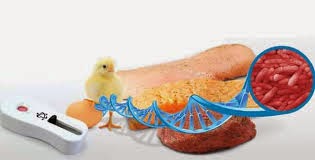Salmonella is one of the major causes of foodborne disease in industrialized nations and that its incidence is increasing.
The main reservoir for salmonellae is the the intestinal tract of animals.
Meat and poultry products are thus prime offenders.As many as half of healthy poultry and one quarter of healthy cattle have been shown to harbor this organism. 0.2-5.0% of people in the United States are chronic carriers.
salmonellae can thrive in many foods because of their simple nutritional requirements and ability to grow under both aerobic and anaerobic conditions. Furthermore, they can exit over a diverse range of pH an temperature. Most strains are heat sensitive, although some strains isolated from eggs and meat exhibit heat resistance. Drying or freezing does not kill all of them. Some strains can grow slowly at moderate refrigeration temperatures, e.g, over 45F.
Sources:

- Salmonella sources
Some of the most common sources of salmonellae are
egg and poultry products.
Products containing dried or processed eggs.
The egg is contaminated with the organism when it is laid and causes a problem unless the organism is later killed by heat.
S. enteritis has become a problem because of infected flocks.
Other sources of salmonellae foodborne infections include commercial ice cream prepared from processed eggs and homemade ice cream made with raw eggs.
Deli salads
Sandwiches
Cold roast meats.
Reheated sauces and gravies are also prime culprits.
Infected food handlers have appeared to be responsible for several outbreaks of salmonellosis in fast food restaurants.
The organism is found in many foods because of cross-contamination.
Improperly cleaned counter tops, cutting boards, and utensils used for uncooked meat and poultry may serve to inoculate other foods.
Recent studies of sprouting kits showed that salmonellae quickly reached hazardous levels during the growing period.
scientific facts about Salmonella:
There is a facts that says: Most outbreaks occur between May and December .
Milk and Salmonella species have always been linked.
Salmonella species were found in 60%of raw milk samples tested .
Because of the widespread use of pasteurization , most of the recent outbreaks were associated with raw milk, while certified raw milk and pasteurized milk were thought to be safe. However certification of milk has been shown not to ensure that the milk is pathogen- free.
An outbreak of Salmonellosis affecting nearly 2.000 people in Canada was traced to cheddar cheese made from raw milk.
Salmonella Growth at Various Temperatures
Most species are not killed by freezing temperatures.
The fastest growth time is at body temperature ( 37 C or 98.6 F) At this temperature , Salmonellae double in only 23 minutes.
Thus, if there were 10 organisms in food at breakfast, 8 to 10 generations could form by lunch. This could be a pathogenic level for susceptible individuals.
Symptoms
Symptoms usually occur 12-24 hours after eating an subside in 24-48 hours. They include:
Diarrhea.
Cramps.
Nausea.
Vomiting.
Chills and fever.
Stools may contain mucus or blood.
In severe cases, bacteremia (bacteria in blood)may result and cause severe localized infections such as: meningitis or pneumonia, which can result in permanent impairment or death.
The most severe salmonella infection is caused by S. typhimurium. Its symptoms mimic those of influenza and other viral illnesses, and they worsen with a progressive rise in fever. In contrast to other Salmonella - included gastro-enteritis, there is usually no diarrhea. In fact, constipation is a common feature.
Treatment with antibiotics should be used only in severe cases because the organism quickly develops resistance.
Age and individual susceptibility are important determinants of infections.
Infants seem to posses little resistance to this infection and ,if infected, become seriously ill. An adult is much more likely to have intestinal colonization without signs of disease. Susceptibility to Salmonella varies with both both the strain of the organism and the individual .
Studies with healthy male prisoner volunteers showed that the infecting dose varied from 125,000 to 16,000,000 microorganisms.
تعليقات
إرسال تعليق
شكرا على مشاركتك اللطيفة